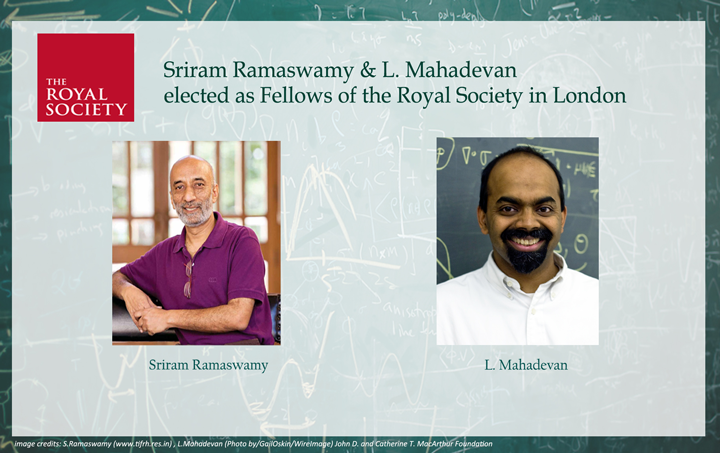Sriram Ramaswamy and L. Mahadevan elected as Fellows of the Royal Society in London
The Bangalore Life Science Cluster, which is collectively comprised of the National Centre for Biological Sciences (NCBS), the Institute for Stem Cell Biology and Regenerative Medicine (inStem) and the Centre for Cellular and Molecular Platforms (C-CAMP) extends its warmest congratulations to Sriram Ramaswamy and Lakshminarayanan Mahadevan on their election as Fellows of the Royal Society in London.
The Royal Society, founded in the 1660s focuses on recognising excellence in science, and works toward promoting and supporting outstanding scientific work. Every year, around 50 noted scientists from the UK and Commonwealth countries are elected to the Society, which currently has close to 1600 of the world's most eminent scientists as Fellows.
Last year saw three scientists associated with NCBS, Ajay Sood, Kamal Bawa and John Kuriyan elected as Fellows. This year, the trend continues with Sriram Ramaswamy and Lakshminarayanan Mahadevan added to the rolls of elected Fellows of the Royal Society in London.
Sriram Ramaswamy directs the TIFR Centre for Interdisciplinary Sciences in Hyderabad, while on leave from his post as a Professor in the Department of Physics at the Indian Institute of Science, in India. As a theoretician, his research interests broadly lie in investigating soft matter, non-equilibrium statistical physics and the mechanics of living matter focussed on the dynamics of self-driven organisation. Lakshminarayanan Mahadevan is a Professor of Physics, Professor of Organismic and Evolutionary Biology and an England de Valpine Professor of Applied Mathematics at Harvard University, UK. He is a mathematical scientist whose work attempts to understand the dynamic and geometric patterns of shape and flow in living and non-living matter.
Sriram Ramaswamy and Lakshminarayanan Mahadevan are well-known names at the Simons Centre for the Study of Living Machines at NCBS. Madan Rao, a faculty member from the Simons Centre says, "It is a real pleasure to write about the achievements of two fantastic scientists and friends Sriram and Maha - both are closely associated with NCBS and the Simons Centre. Like any top class scientist, they have their own very distinctive styles of research - in the way they question the world, in their approach, and in the way they communicate their ideas."
"Sriram is the acknowledged master in the field of fluctuating hydrodynamics of driven non-equilibrium systems, and has steered the field to new frontiers - the effect of boundary-driven shear on ordered media, the hydrodynamics of a suspension of particles sedimenting under gravity, and more recently, the hydrodynamic description of a collection of active particles, both 'living' and non-living analogues. Sriram has consistently used the concepts of symmetry and conservation with telling effect. The field of active matter, a hydrodynamic description of the mechanical properties, flow, instabilities and pattern formation of a system of 'particles' that convert chemical energy to mechanical work, has become a tidal wave in physics, and was initiated by the seminal paper of Sriram and Aditi Simha. The equations that they write down span a large range of scales, from the collective swimming of fish, to the movement of cells on substrates, to the mechanical properties of the cytoskeleton. It has been a pleasure collaborating with him on many of these aspects, especially on the active mechanics of the cytoskeleton and membranes," he adds.
About Mahadevan, Rao quotes, "Maha inherits the intellectual mantle of D'arcy Thompson in his concern with the interplay between geometry, mechanics and dynamics in a variety of living systems. He has the same eye for beauty, be it in the sinuous movement of reptiles, in the fall of the chiffon or in the quick-snap of the Venus fly-trap, all of which he approaches with the modern tools of geometry and analysis combined with powerful scaling arguments. He has created over the years, a wide ranging oeuvre, with an uncanny knack of turning the ordinary to elegant physics, as in the splashing liquid drops or the magic of flying carpets."
"Sriram and Maha have demonstrated how completely fresh and creative perspectives can be used to crack difficult problems in biology. Their approaches have inspired generations of students trained in mathematics and physics to take the plunge into life sciences research. Both Sriram and Maha were instrumental in nucleating the Simons Centre at NCBS, and they continue to serve as role models for us," says Mukund Thattai, another faculty member from the Simons Centre.
"It is tremendous to hear that Sriram and Maha have been elected to the Royal Society. It is a double treat to be able to receive this news. Sriram has been engaged with NCBS for the long term, encouraging our engagement with theory, especially in active matter. He is one of a kind and a real original. Mahadevan (Maha to us), has also been very closely associated with NCBS-TIFR, and was a strong motivation for us to establish the Simons Centre at NCBS. We at NCBS-TIFR are proud to be associated with these outstanding scientists," says Satyajit Mayor, the Director of NCBS and inStem.
For more about the recently elected Fellows of the Royal Society, please visit: https://royalsociety.org/news/2016/04/new-fellows-2016/

Comments
Post new comment